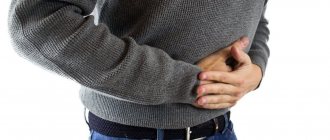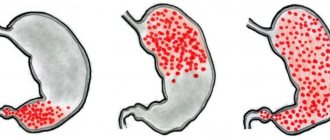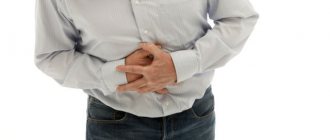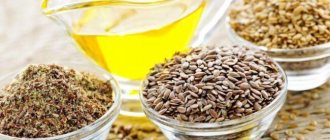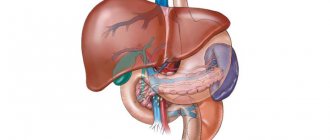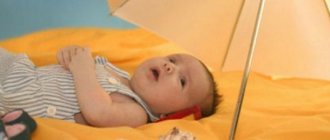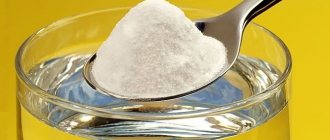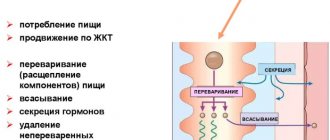The name of this disease is taken from Greek, and means the descent of the stomach below the line of its location. In a normal position, the lower line of the stomach should be 2 fingers above the navel. However, there is a descent to the level of the navel and below. There are known cases of prolapse of up to 10 centimeters. Prolapse of the stomach entails anatomical restructuring of all abdominal organs. What treatment is necessary for gastroptosis?
What is gastroptosis?
Stomach prolapse is gastroptosis
Gastroptosis does not have a significant effect on the digestive processes; constipation occurs only in particularly critical cases, with the development of the 3rd degree of the disease.
Causes of gastroptosis
Pathology can be:
- congenital
- acquired.
Acquired prolapse of the stomach occurs due to asthenia of muscle tissue, sprain of the ligaments that hold the organ. Such a weakening can be caused by:
- fast weight loss,
- surgical intervention in the abdominal cavity,
- childbirth (women)
- vitamin deficiency, lack of protein in the diet
Women of childbearing age suffer from this disease more often than others, since pregnancy often provokes this pathology. One of the reasons for such a frequent occurrence of this pathology during the childbirth period is that many women (some out of ignorance, some out of thoughtlessness) do not wear a bandage that supports the fetus during this period. As a result, the ligaments holding the stomach and other organs are stretched.
Gastric prolapse can be complete (when the entire organ prolapses) or partial. Moreover, partial prolapse is much more common. Partial gastroptosis (anthropyroptosis) is characterized by lengthening of the cavity, as a result of which the intestines descend downwards. With complete gastroptosis, the diaphragm descends first, which pulls the stomach down. Similar pathologies of the diaphragm and stomach can result from pulmonary pathologies such as pleurisy or emphysema. As it descends, the severity of the patient's condition is determined.
When prolapse occurs, compression occurs on the underlying organs, and in particular the pelvic organs, which leads to circulatory problems. And this causes menstrual irregularities, the development of diseases such as fibroids and endometriosis in women, and prostatitis in men. Gastroptosis can also cause the development of hemorrhoids.
Is it possible to avoid surgery?
Many people have already avoided surgical intervention associated with displacement of the pelvic organs, including uterine prolapse. Special exercises will help increase the elasticity of the muscles of the pelvic floor, abdominal wall, back, and improve the condition of the whole body:
- Tilt your head slightly forward, take a deep breath, exhale, holding your breath using the chest, pull in your stomach and hold in this position.
- Strongly tense and relax the pelvic muscles. Repeat 5-6 times. This exercise is useful for lifting the organs located in the pelvis.
- While lying in bed, before going to bed, do this exercise: take a deep breath, and then take a long exhale. This should be repeated several times. The exercise will “put” the organs in place, make your abs strong and your waist thinner.
Symptoms of prolapsed stomach
Gastroptosis has three distinct stages. In the first two stages, the disease is sluggish. The patient may not even suspect the presence of pathology. In some cases, there is a feeling of heaviness, especially after a heavy meal. Some patients notice an instability of appetite and a craving for spicy seasonings.
Often patients with gastroptosis suffer from flatulence, belching, and nausea. Sometimes constipation is a consequence of gastroptosis. It is difficult for feces to move through the intestines due to the prolapse of the transverse colon and a decrease in the contractile function of intestinal motility.
Features of congenital gastroptosis
Patients suffering from congenital gastric prolapse experience:
- Circulatory disorders
- Cardiopalmus,
- Nervousness,
- Dermographism of the arms and legs.
- Patients with congenital prolapse usually have a narrow chest and a thin build.
Third stage
The third stage of the disease is much more severe, and may be accompanied by prolapse of other life-support organs - the liver, kidneys. At this stage, the patient experiences acute pain, especially in the lower abdomen. The pain worsens with a sudden change in body position, and usually subsides if the patient lies down.
Often, prolapse is accompanied by decreased tone and, as a consequence, a decrease in the secretory function of the stomach. Drug treatment is not capable of producing any significant results; surgical intervention is resorted to in exceptional cases, since this method usually gives a temporary result.
A unique technique from Bubnovsky
Dr. Bubnovsky is known for his unique exercises that help sick people get back on their feet.
Just a few exercises will help put your organs back in place.
Abdominal retraction
I.P. lying on your back, bend your legs, put a ball on your stomach. Retract and relax your abs.
You should start with 20 repetitions, then increase to 50. By regularly performing the exercise, you can tighten the “hanging” stomach and lift the internal organs.
It is also recommended for constipation, biliary dyskinesia, hemorrhoids, and poor bowel function.
Twisting
I.P. the same. Place your legs bent at the knees on a chair and cover your ears with your hands. As you exhale, say: “Haa!”, touch your elbows to your knees. Great for strengthening your abs. Repeat - 20 times.
Reverse twist
In the same starting position, grab a solid support with your hands.
Exhaling, say “Haa!”, raise your legs straight, you can bend them a little. We must try to reach the support. Repeat up to 20 times.
Blood circulation in the internal organs will improve, and the intestines will begin to work better. If there is osteochondrosis, then the person gets relief.
There are contraindications: inguinal and umbilical hernia, acute pain in the spine, exacerbation of hemorrhoids.
Twisting to the side
Lying on your back, spread your arms to the sides.
Bend your legs at the knees and raise them at approximately an angle of 90 degrees. After exhaling “Haa!”, begin to lower your legs left and right, touching the floor with your knees, without lifting your palms and shoulder blades. Do 10–20 times in each direction.
Perfectly strengthens the waist muscles. It is useful to perform for osteochondrosis of the lumbar spine.
Contraindications: liver disease, urolithiasis and cholelithiasis in the acute phase, hernias, cholecystectomy (first six months).
Bike
Also lie on your back, press your palms to your ears.
With your left hand, touch your right knee, and straighten your left limb, but do not touch the floor. Then with the other foot. Perform up to 20 times.
Exercise is recommended for weak abdominal muscles, osteochondrosis of the thoracic spine, gastrointestinal diseases (gastroduodenitis, colitis, biliary dyskinesia, weak intestinal function). It is useful for men to do with prostatitis.
Rolling on the ball
This exercise should be performed on an empty stomach, drinking a cup of water in small sips before performing it.
You need to lie on your stomach on the ball.
Start rolling on the ball in clockwise circles - 5-10 circles.
Contraindications: pyelonephritis in the acute period, hemorrhoids, prolapse of internal organs.
The exercise is recommended for biliary dyskinesia, Crohn's disease and constipation.
Treatment of gastroptosis
For gastroptosis, it is recommended to wear a special bandage
When gastroptosis is diagnosed, physical inactivity, and especially adynamia, are not recommended. A sedentary lifestyle can worsen the situation. The patient must move: walk, do some work. But, of course, don't overexert yourself. Lifting weights is contraindicated for a patient suffering from organ prolapse.
The main method of treatment is therapeutic exercises, which help strengthen the muscle tissue of the abdominal ligaments, and massage. Self-massage of the abdomen with light pressure and stroking will also not hurt. Breathing exercises, which force all the abdominal muscles to work, also help strengthen the ligaments.
In case of pain, medications such as no-spa, platifillin, or atropine are recommended. Pharmacies sell special bandages, wearing which also alleviates the patient’s condition.
A set of Kegel exercises
In the 40s of the last century, gynecologist Arnold Kegel from America developed an effective complex for the treatment of urinary incontinence, which is observed in many women after childbirth. Subsequently, this gymnastics became a real salvation for women with uterine prolapse.
Contraindications to performing the complex
- Diseases of the cardiovascular system.
- Complete or partial prolapse of the pelvic organs
- Various tumors.
- Immediately after genital surgery.
Many women found this method to be the most effective. Exercise helps cure many women's diseases. It is also recommended to perform them for their prevention.
Kegel exercises
You need to start gymnastics with a small number of repetitions, gradually increasing their number:
- Lie on your back, bend your knees. Squeeze the vaginal muscles from bottom to top, holding for 30 seconds at each stage. Then relax the muscles in the reverse order. Eliminates uterine bending.
- Exercises to strengthen the muscles of the thighs, vagina and perineum. Performed while standing. Feet slightly wider than shoulder width, place your hands behind your head, sit down, tighten your vagina, hold for 10 seconds.
- In a lying position, alternately tense and relax the muscles of the anus and vagina. Useful to do after childbirth.
- Squeeze the muscles of the vagina and anus at the same time.
- Alternate fast and slow contractions of the muscles of the vagina and anus three times - 10 repetitions.
- Raise your pelvis up, hold it, lower it. Repeat - 5 times.
- Kitty. As you exhale, round your back, draw in your stomach and perineal muscles. As you exhale, bend your back.
Non-traditional methods of treating gastroptosis
Tibetan medicine
Vacuum cans can be considered among the unconventional methods. These are soft rubber jars that vaguely resemble small oven pots. By sucking to the stomach, they improve blood circulation in the skin, and at the same time, affect the tone of the stomach ligaments. This is how Tibetan monks treat prolapsed stomach.
Tibetan jars have nothing in common with glass jars, which until recently were used for colds. And don't try to experiment. Even 30 years ago, doctors noticed that the craze for glass jars had a negative effect on the cardiovascular system. Rubber jars are placed on the stomach area; for this you do not need to light anything in them. The jar is compressed into an accordion and the air is removed from it. And when the doctor places it on the patient’s stomach, it easily suctions.
Traditional medicine in the treatment of gastroptosis
Where traditional medicine is powerless, folk medicine can help. Here are some recipes:
- Finely chop a small head of cabbage and boil it. Pour the broth into a separate bowl, drink it instead of water throughout the day, and use the cabbage in some salad or other dish.
- Pour two teaspoons of St. John's wort into a glass of boiling water, cover and let it brew for half an hour. Then strain. You should drink it in 3 doses throughout the day.
- A dried mixture of the herbs wormwood, centaury, and dandelion roots, chicory and calamus is taken at the rate of 1 tablespoon per glass of boiling water. It is better to insist in a thermos for half an hour. Drink 50 ml half an hour before meals. This composition will promote the production of gastric juice in the stomach and improve appetite.
As with any other disease, gastroptosis is also worth fighting and not losing hope for a healthy life - everyone can choose their own treatment method that will bring the desired result. The main thing is to believe!
Precautionary measures
Considering the specifics of its implementation, the Kegel complex for women has almost no contraindications. Exception:
- Recent miscarriage;
- Premature birth and major surgery;
- The presence of malignant neoplasms;
- Prolapse of the uterus.
In these cases, you should not overexert yourself. But in any case, you should always consult your doctor before starting classes. Even if there are no contraindications, but you feel discomfort or pain during exercise, you should stop and consult a doctor. You can resume training only with the permission of a doctor. A consultation with a gynecologist will be needed if after 3-5 months of regular training there is no change for the better. The rest of the exercises are flawless - there are no strength loads or cardio stress, no need to spend money on exercise machines, equipment, or a trip to the gym. The minimum investment of effort and time will pay off with improved well-being in all areas.
What is the best time to train?
People who have developed the healthy habit of doing exercises in the morning cannot imagine starting their day without squats, push-ups, bending over or stretching. True, among them there are usually more “larks”, because “night owls” can force themselves to get up a few minutes earlier only by force of will, but evening workouts are much more pleasant for them. Thus, if you are not going to break your routine and your nature, then exercise when it is convenient for you
.
There is also a compromise option: do a small set of dynamic exercises in the morning to help you cheer up, and in the evening take time for stretching, yoga and other exercises that will help relieve the stress of the day and prepare for a relaxing evening.

